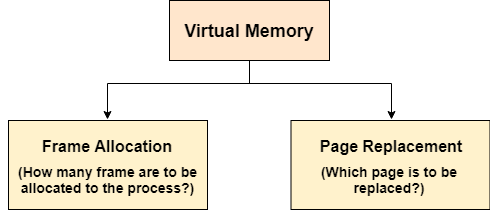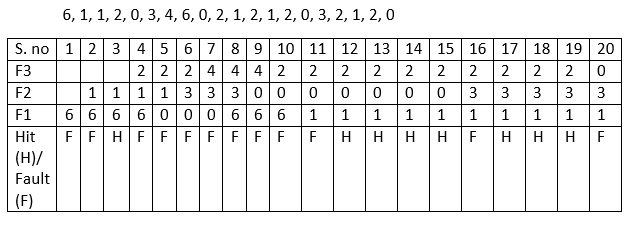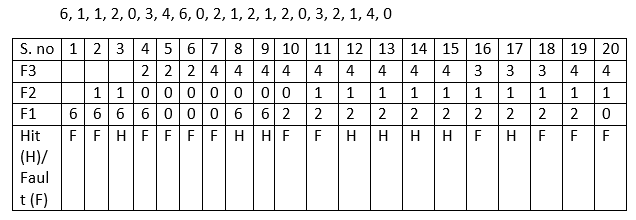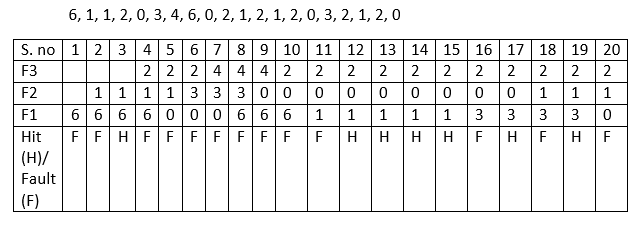Page Replacement Algorithms in Operating Systems (OS)Today we are going to learn about Page Replacement Algorithms in Operating Systems (OS). Before knowing about Page Replacement Algorithms in Operating Systems let us learn about Paging in Operating Systems and also a little about Virtual Memory. Only after understanding the concept of Paging we will understand about Page Replacement Algorithms. Paging in Operating Systems (OS)Paging is a storage mechanism. Paging is used to retrieve processes from secondary memory to primary memory. The main memory is divided into small blocks called pages. Now, each of the pages contains the process which is retrieved into main memory and it is stored in one frame of memory. It is very important to have pages and frames which are of equal sizes which are very useful for mapping and complete utilization of memory. Virtual Memory in Operating Systems (OS)A storage method known as virtual memory gives the user the impression that their main memory is quite large. By considering a portion of secondary memory as the main memory, this is accomplished. By giving the user the impression that there is memory available to load the process, this approach allows them to load larger size programs than the primary memory that is accessible. The Operating System loads the many components of several processes in the main memory as opposed to loading a single large process there. By doing this, the level of multiprogramming will be enhanced, which will increase CPU consumption. Demand PagingThe Demand Paging is a condition which is occurred in the Virtual Memory. We know that the pages of the process are stored in secondary memory. The page is brought to the main memory when required. We do not know when this requirement is going to occur. So, the pages are brought to the main memory when required by the Page Replacement Algorithms. So, the process of calling the pages to main memory to secondary memory upon demand is known as Demand Paging. 
The important jobs of virtual memory in Operating Systems are two. They are:
Frame Allocation in Virtual MemoryDemand paging is used to implement virtual memory, an essential component of operating systems. A page-replacement mechanism and a frame allocation algorithm must be created for demand paging. If you have numerous processes, frame allocation techniques are utilized to determine how many frames to provide to each process. A Physical Address is required by the Central Processing Unit (CPU) for the frame creation and the physical Addressing provides the actual address to the frame created. For each page a frame must be created. Frame Allocation Constraints
Frame Allocation AlgorithmsThere are three types of Frame Allocation Algorithms in Operating Systems. They are: 1) Equal Frame Allocation Algorithms Here, in this Frame Allocation Algorithm we take number of frames and number of processes at once. We divide the number of frames by number of processes. We get the number of frames we must provide for each process. This means if we have 36 frames and 6 processes. For each process 6 frames are allocated. It is not very logical to assign equal frames to all processes in systems with processes of different sizes. A lot of allocated but unused frames will eventually be wasted if a lot of frames are given to a little operation. 2) Proportionate Frame Allocation Algorithms Here, in this Frame Allocation Algorithms we take number of frames based on the process size. For big process more number of frames is allocated. For small processes less number of frames is allocated by the operating system. The problem in the Proportionate Frame Allocation Algorithm is number of frames are wasted in some rare cases. The advantage in Proportionate Frame Allocation Algorithm is that instead of equally, each operation divides the available frames according to its demands. 3) Priority Frame Allocation Algorithms According to the quantity of frame allocations and the processes, priority frame allocation distributes frames. Let's say a process has a high priority and needs more frames; in such case, additional frames will be given to the process. Processes with lower priorities are then later executed in future and first only high priority processes are executed first. Page Replacement AlgorithmsThere are three types of Page Replacement Algorithms. They are:
First in First out Page Replacement AlgorithmThis is the first basic algorithm of Page Replacement Algorithms. This algorithm is basically dependent on the number of frames used. Then each frame takes up the certain page and tries to access it. When the frames are filled then the actual problem starts. The fixed number of frames is filled up with the help of first frames present. This concept is fulfilled with the help of Demand Paging After filling up of the frames, the next page in the waiting queue tries to enter the frame. If the frame is present then, no problem is occurred. Because of the page which is to be searched is already present in the allocated frames. If the page to be searched is found among the frames then, this process is known as Page Hit. If the page to be searched is not found among the frames then, this process is known as Page Fault. When Page Fault occurs this problem arises, then the First In First Out Page Replacement Algorithm comes into picture. The First In First Out (FIFO) Page Replacement Algorithm removes the Page in the frame which is allotted long back. This means the useless page which is in the frame for a longer time is removed and the new page which is in the ready queue and is ready to occupy the frame is allowed by the First In First Out Page Replacement. Let us understand this First In First Out Page Replacement Algorithm working with the help of an example. Example: Consider the reference string 6, 1, 1, 2, 0, 3, 4, 6, 0, 2, 1, 2, 1, 2, 0, 3, 2, 1, 2, 0 for a memory with three frames and calculate number of page faults by using FIFO (First In First Out) Page replacement algorithms. Points to Remember Page Not Found - - - > Page Fault Page Found - - - > Page Hit Reference String: 
Number of Page Hits = 8 Number of Page Faults = 12 The Ratio of Page Hit to the Page Fault = 8 : 12 - - - > 2 : 3 - - - > 0.66 The Page Hit Percentage = 8 *100 / 20 = 40% The Page Fault Percentage = 100 - Page Hit Percentage = 100 - 40 = 60% Explanation First, fill the frames with the initial pages. Then, after the frames are filled we need to create a space in the frames for the new page to occupy. So, with the help of First in First Out Page Replacement Algorithm we remove the frame which contains the page is older among the pages. By removing the older page we give access for the new frame to occupy the empty space created by the First in First out Page Replacement Algorithm. OPTIMAL Page Replacement AlgorithmThis is the second basic algorithm of Page Replacement Algorithms. This algorithm is basically dependent on the number of frames used. Then each frame takes up the certain page and tries to access it. When the frames are filled then the actual problem starts. The fixed number of frames is filled up with the help of first frames present. This concept is fulfilled with the help of Demand Paging After filling up of the frames, the next page in the waiting queue tries to enter the frame. If the frame is present then, no problem is occurred. Because of the page which is to be searched is already present in the allocated frames. If the page to be searched is found among the frames then, this process is known as Page Hit. If the page to be searched is not found among the frames then, this process is known as Page Fault. When Page Fault occurs this problem arises, then the OPTIMAL Page Replacement Algorithm comes into picture. The OPTIMAL Page Replacement Algorithms works on a certain principle. The principle is: Replace the Page which is not used in the Longest Dimension of time in future This principle means that after all the frames are filled then, see the future pages which are to occupy the frames. Go on checking for the pages which are already available in the frames. Choose the page which is at last. Example: Suppose the Reference String is: 0, 3, 4, 6, 0, 2, 1, 2, 1, 2, 0, 3, 2, 1, 2, 0 6, 1, 2 are in the frames occupying the frames. Now we need to enter 0 into the frame by removing one page from the page So, let us check which page number occurs last From the sub sequence 0, 3, 4, 6, 0, 2, 1 we can say that 1 is the last occurring page number. So we can say that 0 can be placed in the frame body by removing 1 from the frame. Let us understand this OPTIMAL Page Replacement Algorithm working with the help of an example. Example: Consider the reference string 6, 1, 1, 2, 0, 3, 4, 6, 0, 2, 1, 2, 1, 2, 0, 3, 2, 1, 4, 0 for a memory with three frames and calculate number of page faults by using OPTIMAL Page replacement algorithms. Points to Remember Page Not Found - - - > Page Fault Page Found - - - > Page Hit Reference String: 
Number of Page Hits = 8 Number of Page Faults = 12 The Ratio of Page Hit to the Page Fault = 8 : 12 - - - > 2 : 3 - - - > 0.66 The Page Hit Percentage = 8 *100 / 20 = 40% The Page Fault Percentage = 100 - Page Hit Percentage = 100 - 40 = 60% Explanation First, fill the frames with the initial pages. Then, after the frames are filled we need to create a space in the frames for the new page to occupy. Here, we would fill the empty spaces with the pages we and the empty frames we have. The problem occurs when there is no space for occupying of pages. We have already known that we would replace the Page which is not used in the Longest Dimension of time in future. There comes a question what if there is absence of page which is in the frame. Suppose the Reference String is: 0, 2, 4, 6, 0, 2, 1, 2, 1, 2, 0, 3, 2, 1, 2, 0 6, 1, 5 are in the frames occupying the frames. Here, we can see that page number 5 is not present in the Reference String. But the number 5 is present in the Frame. So, as the page number 5 is absent we remove it when required and other page can occupy that position. Least Recently Used (LRU) Replacement AlgorithmThis is the last basic algorithm of Page Replacement Algorithms. This algorithm is basically dependent on the number of frames used. Then each frame takes up the certain page and tries to access it. When the frames are filled then the actual problem starts. The fixed number of frames is filled up with the help of first frames present. This concept is fulfilled with the help of Demand Paging After filling up of the frames, the next page in the waiting queue tries to enter the frame. If the frame is present then, no problem is occurred. Because of the page which is to be searched is already present in the allocated frames. If the page to be searched is found among the frames then, this process is known as Page Hit. If the page to be searched is not found among the frames then, this process is known as Page Fault. When Page Fault occurs this problem arises, then the Least Recently Used (LRU) Page Replacement Algorithm comes into picture. The Least Recently Used (LRU) Page Replacement Algorithms works on a certain principle. The principle is: Replace the page with the page which is less dimension of time recently used page in the past. Example: Suppose the Reference String is: 6, 1, 1, 2, 0, 3, 4, 6, 0 The pages with page numbers 6, 1, 2 are in the frames occupying the frames. Now, we need to allot a space for the page numbered 0. Now, we need to travel back into the past to check which page can be replaced. 6 is the oldest page which is available in the Frame. So, replace 6 with the page numbered 0. Let us understand this Least Recently Used (LRU) Page Replacement Algorithm working with the help of an example. Example: Consider the reference string 6, 1, 1, 2, 0, 3, 4, 6, 0, 2, 1, 2, 1, 2, 0, 3, 2, 1, 2, 0 for a memory with three frames and calculate number of page faults by using Least Recently Used (LRU) Page replacement algorithms. Points to Remember Page Not Found - - - > Page Fault Page Found - - - > Page Hit Reference String: 
Number of Page Hits = 7 Number of Page Faults = 13 The Ratio of Page Hit to the Page Fault = 7 : 12 - - - > 0.5833 : 1 The Page Hit Percentage = 7 * 100 / 20 = 35% The Page Fault Percentage = 100 - Page Hit Percentage = 100 - 35 = 65% Explanation First, fill the frames with the initial pages. Then, after the frames are filled we need to create a space in the frames for the new page to occupy. Here, we would fill the empty spaces with the pages we and the empty frames we have. The problem occurs when there is no space for occupying of pages. We have already known that we would replace the Page which is not used in the Longest Dimension of time in past or can be said as the Page which is very far away in the past.
Next TopicGate 2015 question on LRU and FIFO
|
 For Videos Join Our Youtube Channel: Join Now
For Videos Join Our Youtube Channel: Join Now
Feedback
- Send your Feedback to [email protected]
Help Others, Please Share









